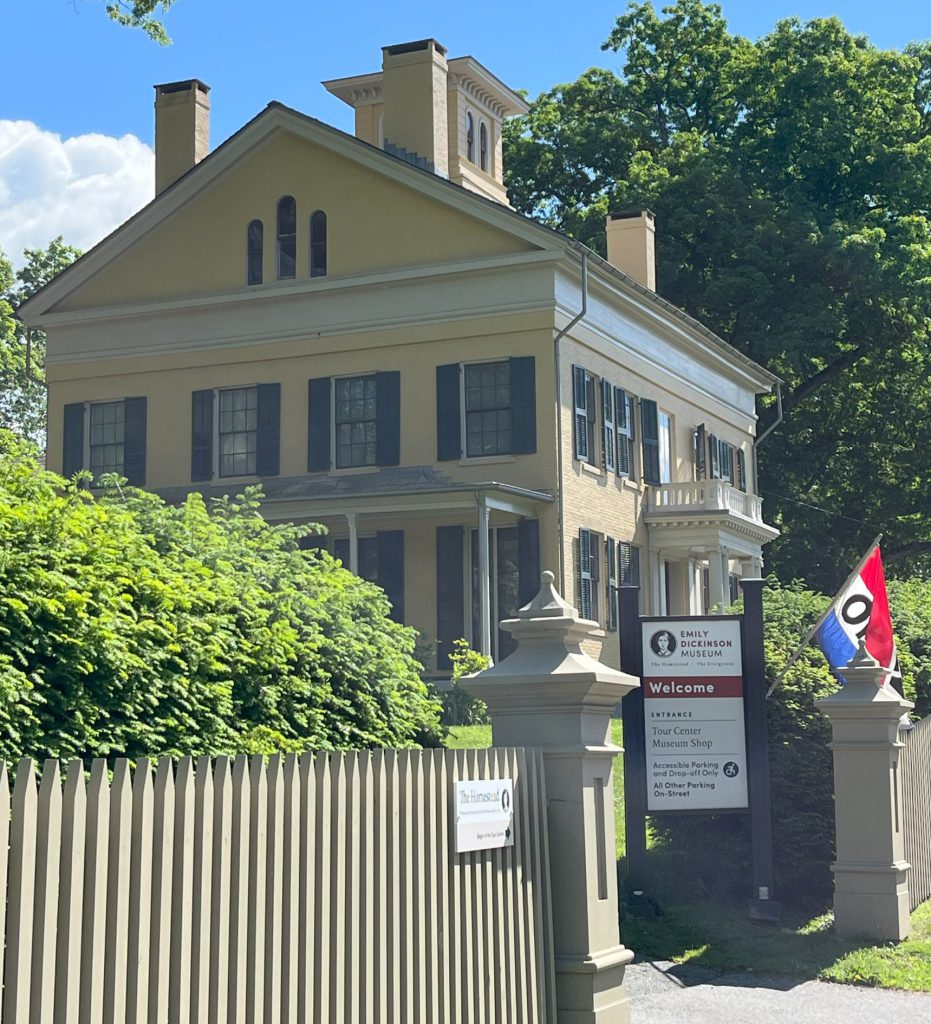 On May 28th, my brother and I embarked on a road trip from South Jersey to Deerfield, Massachusetts. We drove 20 minutes to Amherst to visit Emily Dickinson’s home the next day. The Homestead, as it is called, is situated on a beautiful hilly strip of land that once included an operating farm that her family ran. Emily lived her entire life in this house, having both been born and died within this structure’s walls. Within eye view and a short walking distance from the Homestead is the Evergreens house where Dickinson’s brother Austin and his wife Susan lived. We toured both houses but due to my interest in Emily, I will focus solely on the Homestead.
On May 28th, my brother and I embarked on a road trip from South Jersey to Deerfield, Massachusetts. We drove 20 minutes to Amherst to visit Emily Dickinson’s home the next day. The Homestead, as it is called, is situated on a beautiful hilly strip of land that once included an operating farm that her family ran. Emily lived her entire life in this house, having both been born and died within this structure’s walls. Within eye view and a short walking distance from the Homestead is the Evergreens house where Dickinson’s brother Austin and his wife Susan lived. We toured both houses but due to my interest in Emily, I will focus solely on the Homestead.
Background
Emily, her older brother, William Austin, who went by Austin his entire life, and their younger sibling, Lavinia was born to Edward Dickinson, a lawyer, a Whig Politician, and later a Republican when his former party dissolved, and Emily Norcross, an educated homemaker. The couple had met at a chemistry lecture on February 8, 1826. After several years of correspondence, the couple finally married on May 6, 1828. Austin arrived a year later on April 16, 1829, Emily the following year on December 10, 1830, and Lavinia three years after Emily on February 28, 1833. Edward enforced strict gender roles, which did not restrict all of his children from receiving an education or prevent them from reading material that questioned these values.
Austin taught before following his father’s footsteps and becoming a lawyer. Emily wrote around 1800 poems, with roughly ten published in her lifetime. Thanks to Lavinia, Emily’s poems survived and were published after her death. Emily died on May 15, 1886, at the age of 55, she was survived by Austin who died on August 16, 1895 at 66, and Lavinia who died on August 31, 1899, also at 66.
Because I could not stop for Death –He kindly stopped for me –The Carriage held but just Ourselves –And Immortality.
The Homestead
In c.1813, Emily’s grandparents, Samuel Fowler Dickinson and Lucretia Gunn Dickinson, built her home – the Homestead. Seventeen years later in 1830, Edward and Emily Norcross moved into the family with Austin. The Homestead changed ownership, from Samuel to David Mack in 1833, with Samuel moving to Ohio where he died five years later in 1838. Emily and her family continued their residence at the Homestead with the Macks until 1840, when her family moved to another house that her father had purchased. But her forever home would be the Homestead, in 1850 after David Mack had passed, Edward bought the Homestead, and the Dickinsons resumed their residency. After Emily died, Lavinia remained in the Homestead until her death in 1899. The ownership of the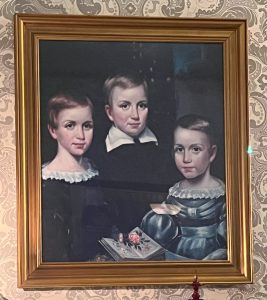 Homestead was then passed to Austin’s daughter, Martha Dickinson Bianchi. Martha leased the house to tenants till 1916, when it changed ownership again, and was acquired by the Parke family. The Parke family owned the house until 1965 when they sold it to Amherst College. By this time, the Homestead was a National Historic Landmark for two years.
Homestead was then passed to Austin’s daughter, Martha Dickinson Bianchi. Martha leased the house to tenants till 1916, when it changed ownership again, and was acquired by the Parke family. The Parke family owned the house until 1965 when they sold it to Amherst College. By this time, the Homestead was a National Historic Landmark for two years.
A precious, mouldering pleasure ‘t is
To meet an antique book,
In just the dress his century wore;
A privilege, I think,
Apple TV’s Dickinson
The Emily Dickinson Museum was a resource for the Apple TV show, titled Dickinson, starring Hailee Steinfeld as Emily Dickinson. The show ran for three seasons from 2019 to 2021. After the show was done airing, the creators donated some of the antique furniture that they had acquired for the set to the Museum. Some of the acquired furniture were the bookshelves currently on display in Edward’s office, in addition to the papers and books that fill the bookshelves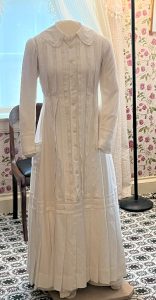 . The Dickinson’s family original papers and clothing are housed at the Amherst Historical Society, Amherst College, Jones Library, College, Yale, and the Boston Public Library.
. The Dickinson’s family original papers and clothing are housed at the Amherst Historical Society, Amherst College, Jones Library, College, Yale, and the Boston Public Library.
The Bee is not afraid of me.
I know the Butterfly.
The pretty people in the Woods
Receive me cordially—
Tour
The tour was guided and was 45 minutes long. It commenced in the hall of the house, with an overview of Emily’s family and the house that had been decorated with the use of research and survival pieces of wallpaper. From the hall, we moved to Edward’s office where his original desk and other furniture that once belonged to him sat. The next space we visited was the sitting room which could be made smaller with sliding doors. On the far side of the room, there was a piano and fireplace in which the portrait of Emily and her two siblings as children hung above. We then climbed the front steps, sliding our hands along the same banister that Emily did during her life. Once on the second floor, we entered a room in which we were encouraged to sit on benches while the tour guide went over the type of poetry Emily wrote and informed us on how she would note options for certain words throughout her poetry to change the meaning of them. From there, we then visited the space I was most excited to be in – Emily’s room. I will discuss her room in a separate section below. Lastly, we were guided into a room that was connected to Emily’s. This was a small room with a bed, where Emily’s mother resided during the final years of her life. Due to its location to Emily’s room, it allowed her to better care and be more available to her mother and her needs.
New feet within my garden go,
New fingers stir the sod;
A troubadour upon the elm
Betrays the solitude.
Emily Dickinson’s Room
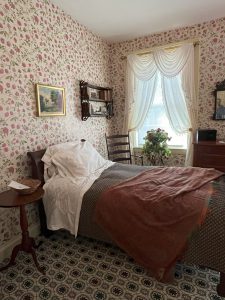 As mentioned, my favorite part of the house was Emily’s room. Upon entering the room, we saw her bed to the left, her mirror was on the far wall behind the bed, and to the right against another wall was her tiny desk near a window and next to the fireplace. In the middle of the room was a reproduction of Emily’s famous white dress. The wallpaper was reproduction based on the design of a surviving piece of the original paper that was based around. As a woman writer, being in her room was very exciting and inspirational. The museum allows individuals to write in her room at an hourly charge. I hope one day to get the chance to write in the same space as Emily did long ago.
As mentioned, my favorite part of the house was Emily’s room. Upon entering the room, we saw her bed to the left, her mirror was on the far wall behind the bed, and to the right against another wall was her tiny desk near a window and next to the fireplace. In the middle of the room was a reproduction of Emily’s famous white dress. The wallpaper was reproduction based on the design of a surviving piece of the original paper that was based around. As a woman writer, being in her room was very exciting and inspirational. The museum allows individuals to write in her room at an hourly charge. I hope one day to get the chance to write in the same space as Emily did long ago.
He ate and drank the precious words, His spirit grew robust; He knew no more that he was poor, Nor that his frame was dust. He danced along the dingy days, And this bequest of wings Was but a book. What liberty A loosened spirit brings!
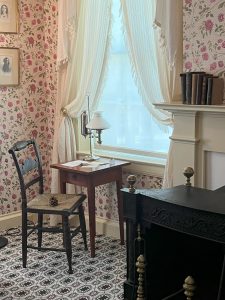
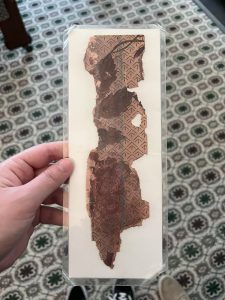
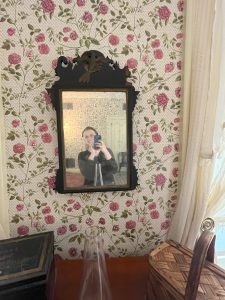
Conclusion
I loved my visit to Emily’s house – The Homestead. My interest in Emily began when watching the show Dickinson. The character of Emily in the show was inspirational at a time when I was in a writing slump. I am thankful to the show and Emily Dickinson for helping me find the magic in writing. I am additionally thankful to the staff and our tour guide who did not just bring Emily to life but also the world in which she existed in. I entered the museum knowing a good deal about Emily and left knowing even more. Thank you so much to the Emily Dickinson Museum and to my brother who went with me – it was an awesome trip and experience!
I started Early—Took my Dog—
And visited the Sea—
The Mermaids in the Basement
Came out to look at me—And Frigates—in the Upper Floor
Extended Hempen Hands—
Presuming Me to be a Mouse—
Aground—upon the Sands—But no Man moved Me—till the Tide
Went past my simple Shoe—
And past my Apron—and my Belt
And past my Bodice—too—And made as He would eat me up—
As wholly as a Dew
Upon a Dandelion’s Sleeve—
And then—I started—too—And He—He followed—close
behind—
I felt His Silver Heel
Upon my Ankle—Then my Shoes
Would overflow with Pearl—Until we met the Solid Town—
No One He seemed to Know—
And bowing—with a Mighty look—
At me—The Sea withdrew—
I hope you enjoyed it and thank you so much for reading it!
Sources:
“Learn,” Emily Dickinson Museum, https://www.emilydickinsonmuseum.org/
Alfred Habegger, “Chapter 3,” My Wars are Laid Away in Books, (Modern Library, 2002).

Athena says
How delightful! I wonder what you might have been doing at (Historic?) Deerfield? My favorite museum there is Memorial Hall because of the “door”. I hope you had time for tea in the Beehive Room of the Old Deerfield Inn. When I first came to to UMass Amherst in 1977 I was exploring on foot and came across the Emily Dickinson house which maybe gave some tours but was mostly used as a house for visiting faculty. I loved watching the small garden grow and, once, I saw a magnificent (or interesting, hey it was 50 years ago, lol) bush in front of the Evergreens. I tiptoed quietly past the “No Trespassing” sign to examine the bush when an older woman stepped out onto the porch and inquired what I was doing. She took pity on me seeing as I was interested in the flowering bush and just said, “Next time be sure to knock first.” I guess that was Martha Dickinson Bianchi!